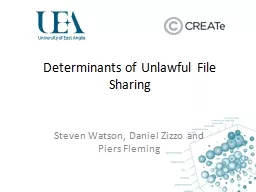

Steven Watson Daniel Zizzo and Piers Fleming Scoping Review of Existing Research 54441 articles Academic Literature Keyword Search 122 articles Companies and Organisations eg OFCOM ID: 565258
Download Presentation The PPT/PDF document "Determinants of Unlawful File Sharing" is the property of its rightful owner. Permission is granted to download and print the materials on this web site for personal, non-commercial use only, and to display it on your personal computer provided you do not modify the materials and that you retain all copyright notices contained in the materials. By downloading content from our website, you accept the terms of this agreement.
Slide1
Determinants of Unlawful File Sharing
Steven Watson, Daniel
Zizzo and Piers FlemingSlide2
Scoping Review of Existing Research
54,441 articles: Academic Literature
Keyword Search
122 articles:Companies and Organisations(e.g. OFCOM)
Abstracts Screened -> Text Screened
206 included articles
Empirical, primary data about people’s unlawful file sharing of digital media
2003-2013Slide3
Why do people file share unlawfully?
UFSSlide4
Proximity to actual behaviour
Outcome Measure
Definition
Qualitative researchExplorations of perceptions of or engagement in behaviors without quantitative assessment.
Stated preferences and attitudes
Outcome is at the level of how good or bad, right or wrong, or preferable an action is perceived to be
Intentions to perform behavior
Outcome described participants reports of behavior that they plan to engage in in the future
Willingness to pay (WTP)
Outcome represents the amount of money that a participant states they are willing to pay in order to obtain a good
Stated behavior
Outcome represents a participant’s report of behavior that has been engaged in in the past, such as from a survey
Observed behavior
Outcome represents behavior that is either directly observed at the level of the individual, such as in an experiment, or else at the population level, such as from sales dataSlide5
Why do people file share unlawfully?Slide6
Replace/Generate
Sales and Unlawful File Sharing (UFS)UFS may replace sales, e.g. anecdotally the emergence of Napster coincided with a decline in music sales (
Liebowitz, 2006)Most evidence suggests potential sales of music and movies are decreased by UFS.However, UFS may generate sales by promoting interest.There is strong evidence that for individuals more UFS is associated with more actual sales.
Unlawful file sharing
Sales
40-60% of evidence
> 60% of evidence
-
ve
associationSlide7
Replace/Generate
Financial & Legal UtilityStronger laws appear to reduce unlawful file sharing, but effect may be temporary and limited behavioral data confirming causal legal effect
Many people are unaware of what is lawful (Ofcom, 2011) or it doesn’t feel like a crime (BMRB Social Research, 2009).
High prices appear to reduce sales, lower willingness to pay for content is associated with UFS
Unlawful file sharing
Sales
40-60% of evidence
> 60% of evidence
-
ve
association
Lower WTP
Less strict laws
Lower Prices
Less Perceived
DeterrentSlide8
Replace/Generate
Experiential Utility
Unlawful file sharing may be influenced by a desire to sample new content, to access niche content, to build a collection or general interest in the content UFS provides access to difficult to find content (Sandulli
, 2007; Mateus & Peta, 2008)
Unlawful file sharing
Sales
40-60% of evidence
> 60% of evidence
-
ve
association
InterestSlide9
Replace/Generate
Technical
Unlawful file sharing
Sales
40-60% of evidence
> 60% of evidence
-
ve
association
Access to internet
Ability to file share
Closing file sharing sites
Long release lag (availability)
(Physical
Sales)
Clear effects
of availability
Initial barrier to unlawful file sharing?Slide10
Replace/Generate
Social Utility
Unlawful file sharing
Sales
40-60% of evidence
> 60% of evidence
-
ve
association
Others beliefs and behaviour
Correlation UFS and peer UFS
...
But need observed behavioural and causal evidenceSlide11
Replace/Generate
Moral Utility
Unlawful file sharing
Sales
40-60% of evidence
> 60% of evidence
-
ve
association
UFS enhances social welfare
UFS doesn’t cause harm
Correlation UFS and moral beliefs
...
But need observed behavioural and causal evidence
UFS is immoralSlide12
ExperimentParticipants had the choice to purchase legally, obtain without paying or do nothing
The risk and penalty of being caught was known and varied across trialsGoods came from a producer who made a profit if they were paid forPreliminary findings: Risk preferences matter, financial and legal consequences matter, if the producer had put in a lot of effort to make the product UFS was lower. Slide13
ConclusionsUnderstanding the why of file sharing is essential to understand the
how of changing file sharing from a policy viewpointLegal and financial are importantBut so are moral, social, technical and experientialFuture research should consider multiple factors and
specific media.Slide14
Thanks for your attention!Slide15